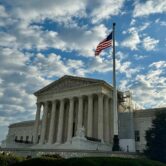SAN FRANCISCO (CN) – Pacific Gas and Electric customers who lost power for days during a series of large-scale fire-prevention power blackouts cannot sue the company for $2.5 billion in damages, a federal bankruptcy judge ruled Monday.
U.S. Bankruptcy Judge Dennis Montali found PG&E is immune from liability for executing public safety power shutoffs through a process approved by the California Public Utilities Commission (CPUC).
“Any such claim interferes with the CPUC’s exclusive regulatory authority over such shutoffs,” Montali wrote in an 11-page opinion.
Napa County grape grower Anthony Gantner sued PG&E in December, claiming years of neglected maintenance by the company made its widely unpopular power shutoffs necessary to prevent wildfires in dry and windy conditions. Gantner sought punitive damages for three planned power outages that occurred Oct. 9-12, Oct. 23-Nov. 1, and Nov. 20-22, 2019. The blackouts cut power for 800,000 to 1 million households, affecting millions of people.
Gantner said the power shutoffs rendered homes and businesses uninhabitable, caused a loss of phone reception and led to spoiled food in unpowered freezers and refrigerators. It also cost worker productivity and caused businesses to lose money. He further complained of extra costs incurred from buying candles, flashlights, batteries, and gas generators.
During a March 10 hearing, Gantner’s attorney Nicholas Carlin argued that his client did not seek to hold PG&E liable for the process it used to deploy power blackouts. Rather, he sought to impose liability based on the company’s well documented pattern of neglect in clearing trees and maintaining power equipment.
“They were forced to engage in these massive shutdowns because of their lack of maintenance,” Carlin told the judge.
Montali rejected that argument Monday, finding the maintenance issues were not directly tied to the loss of business and extra costs associated with power blackouts.
“The proximate causal connection between the harms suffered by plaintiff during the blackouts (loss of habitability of his dwelling, loss of cellphone connectivity) and the conditions predating those blackouts is too remote,” Montali wrote.
The fact that such power shutoffs might still be necessary during dry and windy conditions regardless of past maintenance supports the lack of a direct link between the alleged misconduct and injury, the judge added.
In an opposition brief, Gantner’s lawyers argued making PG&E immune from lawsuits just because the power blackouts are regulated by the CPUC would be “akin to saying that PG&E should not be liable for negligently causing the San Bruno explosion or the wildfires just because the commission regulates aspects of PG&E’s conduct related to those disasters.”
Countering that argument, Montali pointed out that damages asserted by victims of the 2010 San Bruno gas pipeline explosion did not arise from conduct approved by the CPUC. He also noted a direct connection between those damages and the company’s conduct.
“The losses and damages asserted by the San Bruno explosion victims and the wildfire victims were directly related and causally connected to the utility’s alleged misconduct,” Montali wrote in a footnote.
Montali agreed with the CPUC’s position that it retains exclusive authority to punish PG&E for conduct related to its power safety shutoffs.
CPUC President Marybel Batjer harshly criticized PG&E for its handling of the Oct. 9-12 blackout during a public meeting this past October. The company was chided for poor planning, insufficient coordination with local governments, a downed website, an overwhelmed call center and a failure to set up emergency resource centers in affected communities, among other problems. PG&E later agreed to provide rebates to customers affected by the Oct. 9 power shutoffs.
In November, the CPUC also ordered PG&E to show cause why it should not be sanctioned for failing to properly communicate with customers during the power shutoffs. That investigation remains ongoing.
“By asserting that inadequate maintenance led to the [public safety power shutoffs], plaintiff is usurping and interfering with the CPUC’s authority in approving such PSPS events,” Montali wrote.
Reached by email, Gantner’s attorney Carlin said he believes Montali’s opinion is “100% wrong” and plans to appeal.
“Judge Montali just told 1 million households in California who were harmed by these blackouts to stuff it,” Carlin said.
The plaintiffs’ lawyer insisted no evidence exists showing how this lawsuit would hinder the CPUC’s ability to regulate PG&E. Any such assertion is a question of fact that should be decided at a later stage of litigation, he added.
Carlin was especially miffed that the judge denied his client leave to amend the complaint.
“We appreciate that Judge Montali wants to move this bankruptcy case toward conclusion by the June 30 deadline and that this case had the potential to ‘muck up the works,’ but that is no justification for denying 1 million Californians their day in court,” Carlin said.
PG&E spokeswoman Ari Vanrenen said the company believes the dismissal is in the best interest of all parties.
“We recognize that turning power off is a hardship for our customers and communities, and it is not a decision we make lightly,” Vanrenen said. “PG&E proactively turns off power for one reason only: to keep customers and communities safe.”
Subscribe to Closing Arguments
Sign up for new weekly newsletter Closing Arguments to get the latest about ongoing trials, major litigation and hot cases and rulings in courthouses around the U.S. and the world.









